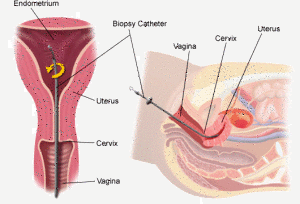What is an endometrial biopsy? What does it have to do with infertility?
An endometrial biopsy is a test that evaluates the endometrial tissue that lines the inside walls of your uterus. It is not the same as an ERA test for IVF.
Around the time you ovulate (release an egg from your ovary), your endometrium (inside lining of your uterus) grows thick with blood vessels, glands and stored nutrients to allow a fertilized egg to implant and grow.
If fertilization does not occur, the endometrial tissue sheds as menstrual flow to mark the beginning of your next cycle. Progesterone and estrogen control the growth and stabilization of the endometrial tissue.
If your body doesn’t produce enough of these hormones, your uterus may not be able to maintain a pregnancy.
How to prepare for an endometrial biopsy
An endometrial biopsy is taken by your doctor and then sent to a pathologist who will examine the sample of our endometrial tissue under a microscope. Your doctor can tell if your body is producing enough of these hormones by its thickness and pattern.
If your body is not producing enough hormones, medication may be prescribed to regulate them.
How is an endometrial biopsy done?
You doctor will place a speculum inside your vagina, insert a small catheter through your cervix into your uterus, and remove a small sample of the endometrial lining. It usually takes just a few seconds. You may feel a pinch or some cramping.
Recovery: What to expect after a uterine biopsy
You may have mild cramps an hour or so after the procedure and you may also have vaginal spotting. Light bleeding and spotting can last until you have your next period.
How long does it take to get my endometrial biopsy results?
It may take as long as 7 to 10 business days to prepare and interpret the biopsy results.
What is the best time for an endometrial biopsy in infertility?
This test is usually done around day 21 of your cycle. Your endometrium should be very thick at this time in your menstrual cycle.
You will need to let your doctor know when your period actually begins. Your doctor will then compare the date your period actually started with the date it should have started , based on the thickness and pattern of the tissue sample. If there is a big difference between these dates, it may mean your endometrium is not sufficient.
What are endometrial biopsy risks?
There is a slight change that the biopsy may disrupt and early pregnancy if you happen to be pregnant when the test is performed. To avoid this potential problem, your doctor may want you to avoid pregnancy during the month you are taking this test.
You may also have to take pregnancy test before you have the biopsy to make sure you’re not pregnant.
Though not a “risk”, it’s also important to learn about endometriosis which is linked to infertility.




